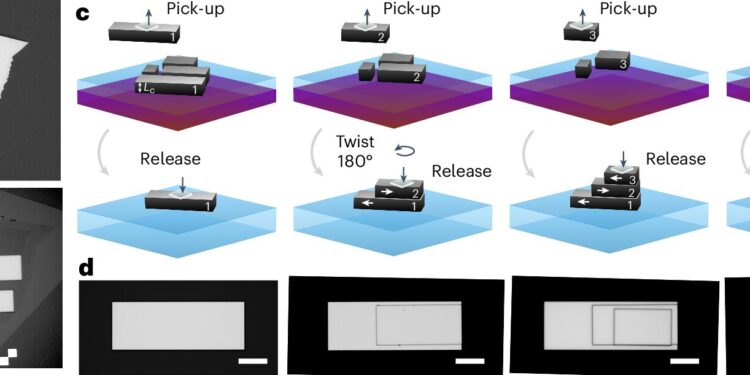PPTMD. A,bMicrograph of 3R-MoS2 snowflake before (A) and after (b) modeling (electron beam lithography, engraving). cStacking procedure. Slab 1 is first transferred to a 500 µm thick SiO2 transparent substrate. Slab 2 is twisted by 180° and released onto slab 1. Slab 3 is transferred to slab 2. Finally, slab 4 is twisted by 180° and released onto the 3 stacked portions. dMicrographs of each stacking stage. Scale bars, 10 μm. Credit: Natural photonics (2025). DOI: 10.1038/s41566-024-01602-z
Physicists have spent more than a century measuring and understanding the strange ways that photons, electrons, and other subatomic particles interact on extremely small scales. Engineers have spent decades figuring out how to take advantage of these phenomena to create new technologies.
In one such phenomenon, called quantum entanglement, pairs of photons interconnect in such a way that the state of one photon instantly changes to match the state of its paired photon, regardless of their distance.
Nearly 80 years ago, Albert Einstein referred to this phenomenon as “spooky action at a distance.” Today, entanglement is the subject of research programs around the world and is becoming a preferred means of implementing the most fundamental form of quantum information, the qubit.
Currently, the most efficient way to create photon pairs is to send light waves through a crystal large enough to be seen without a microscope.
In an article published in Natural photonicsA team led by Columbia Engineering researchers and collaborators describes a new method for creating these photon pairs that achieves higher performance on a much smaller device using less energy. P. James Schuck, associate professor of mechanical engineering at Columbia Engineering, helped lead the research team.
These discoveries represent a significant advance in the field of nonlinear optics, which concerns the use of technologies to modify the properties of light for applications such as lasers, telecommunications and laboratory equipment.
“This work represents the embodiment of the long-sought goal of bridging nonlinear and quantum macroscopic and microscopic optics,” says Schuck, who co-directs Columbia’s MS in Quantum Science and Technology. “It forms the basis for scalable and highly efficient on-chip integrable devices, such as microscopic tunable generators of entangled photon pairs.”
Study authors P. James Schuck (left) and Chiara Trovatello of the Schuck lab at Columbia Engineering. Credit: Jane Nisselson/Columbia Engineering
How it works
Measuring just 3.4 micrometers thick, the new device portends a future in which this important component of many quantum systems can fit onto a silicon chip. This change would enable significant gains in energy efficiency and overall technical capabilities of quantum devices.
To create the device, the researchers used thin crystals of a van der Waals semiconductor transition metal called molybdenum disulfide. Then they stacked six of these crystal pieces, with each piece rotated 180 degrees relative to the crystal slabs above and below.
When light passes through this stack, a phenomenon called quasi-phase matching manipulates the properties of light, allowing the creation of paired photons.
This paper represents the first time that quasi-phase matching in a Van der Waals material has been used to generate photon pairs at wavelengths useful for telecommunications. The technique is significantly more efficient than previous methods and much less error-prone.
“We believe this advancement will make van der Waals materials the heart of next-generation nonlinear and quantum photonic architectures, and that they will be ideal candidates to enable all future on-chip technologies and replace current bulk and periodic crystals. polarized,” Schuck said.
“These innovations will have an immediate impact in various areas, including satellite distribution and quantum mobile communication.”
How it happened
Schuck and his team built on their previous work to develop the new device. In 2022, the group demonstrated that materials like molybdenum disulfide had useful properties for nonlinear optics, but that their performance was limited by the tendency of light waves to interfere with each other as they traveled through through this material.
The team turned to a technique called periodic polarization to counteract this problem, known as phase matching. By alternating the direction of tiles in the stack, the device manipulates light in a way that allows the generation of photon pairs at tiny length scales.
“Once we understood how amazing this material was, we knew we needed to pursue periodic polarization, which could enable the very efficient generation of photon pairs,” says Schuck.
More information:
Chiara Trovatello et al, Quasi-phase-matched up- and down-conversion in periodically polarized layered semiconductors, Natural photonics (2025). DOI: 10.1038/s41566-024-01602-z
Provided by Columbia University School of Engineering and Applied Sciences
Quote: Engineering quantum entanglement at the nanoscale (January 14, 2025) retrieved January 14, 2025 from
This document is subject to copyright. Except for fair use for private study or research purposes, no part may be reproduced without written permission. The content is provided for informational purposes only.



